A Series of Blogposts
Our blog on Manuscript Studies, begun in 2015, reports and illustrates a variety of manuscripts, fragments, and documents, sometimes with seals included. In keeping with our interests in manuscript and other evidence, some posts consider printed materials, including early printed evidence.
Some posts include Booklets downloadable in PDF format. The Booklets are set in our copyright font Bembino (available for FREE) and laid out according to the principles of our Style Manifesto.
The materials belong to different owners, who allow us to study these materials long-term and report the research results, with photographs reproduced by permission.
With guest bloggers as they can join us, our Director Mildred Budny produces many of the blogposts. You could learn more about her work, activities, and interests, and view her Curriculum Vitae on Mildred Budny: Her Page.
Some Posts report discoveries relating to Items in Mildred Budny’s Illustrated Handlist of Medieval and Early Modern Manuscripts, Documents, and Printed Materials. They are indicated here by Handlist Numbers in red.
Do you have a blogpost to contribute? Do you have suggestions for subjects? We welcome your imput.
*****
With thanks to Susan L’Engle for including it in the newsletter Manuscripts on My Mind: News from the Vatican Film Library, a first list of the posts was reported in Number 16 (page 15). This discourse gave inspiration for preparing a list of the posts as they appear.
You are Here.
We provide a Contents List for these Reports, grouped mostly by subjects. The groups so far:
The Prequel: Preludes to our Blog
Virtual Exhibitions (“1. Galleries” and “2. Specimens of Watermarks”)
Our Blog on “Manuscript Studies”: Contents by Category
I. Setting the Stage
II. Documents in Question
III. Isolated Manuscript Fragments (Bits & Pieces)
IV. Dispersed Manuscript Fragments Reassembled, at Least Virtually (Otto Ege Manuscripts included)
V. Manuscript Leaves or Bifolia Reused as Covers for Later Materials and Still In Situ
VI. Manuscripts and Composite Manuscripts
VII. Early Printed Materials
VIII. Books Telling Stories
IX. For Future Reference [More to come . . . ]
The Prequel
Some posts and pages on our website, once it had been updated so as to carry images, paved the way for this blog. For example:
Research Group Archives
Records in written, visual, material, and digital forms report moments, stages, and activities in the life of the Research Group on Manuscript Evidence, with observations on the creation of the blog on Manuscript Studies.

Galleries: Images on Exhibition
With their own Contents List, the Galleries display specimens (or “Parades”) of Scripts & Texts through the ages, from Antiquity to the Modern Age, as well as examples of our own Designs & Layout.
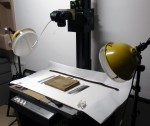
A Pilgrim’s Progress
Recollections of strangers’ hospitality in Switzerland in early spring on the way to the Stiftsbibliothek in Saint Gallen to examine its early medieval manuscripts, including some made or inspired by Insular artists — pilgrims? — from the British Isles.
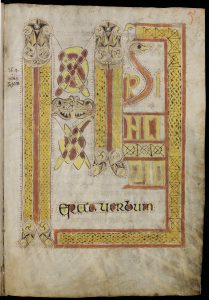
St. Gallen, Stiftsbibliothek, Cod. Sang. 60: ‘Evangelium S. Johannis’ via https://www.e-codices.unifr.ch/en/list/one/csg/0060.
‘Show & Tell’ Seminar on Manuscripts & Their Photographs
Reflections on the photography of manuscripts and written materials made under a variety of conditions, revealing aspects that a single image could not.
Virtual Exhibitions
Some Pages on this site gather images of original materials for study, research, teaching, and exhibition. With a range that continues to grow, the Galleries offer scope for exhibition of specimens and examples, from which sometimes emerge fuller reports or case-studies for our blog (see its Contents List below). In turn, as our blog continues to expand, with more research discoveries, we set up another Page for Specimens focused specifically on Watermarks and their Paper, so as to gather cases encountered in our blog and other research on materials of varied dates, origins,and purposes.
1. Galleries
The Galleries showcase a variety of images and designs. A Contents List describes some of the range, which continues to grow.
I. Specimens of Scripts, Writing Systems & Texts through the Ages
From Antiquity to the Modern World
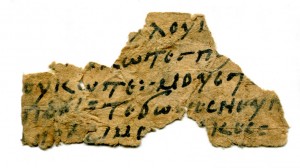
Private Collection, Coptic fragment on paper, 10th century CE.
II. Examples of Design & Layout by the Research Group on Manuscript Evidence
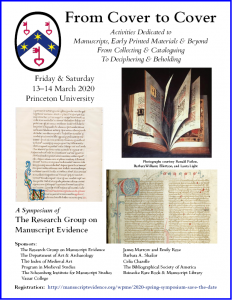
2020 Symposium Poster 2
2. Specimens of Watermarks
Watermarks & the History of Paper
With a view toward presentation in searchable database format, we gather specimens of Watermarks, some with dated or datable usage, found on paper in manuscripts, documents, printed materials, and other locations, from a variety of times and places.
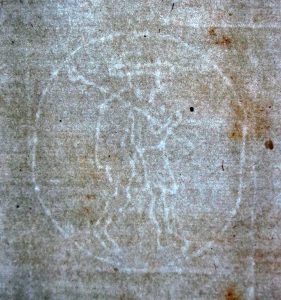
Private Collection, Endpaper with Pilgrim Watermark.
Now see also
- David W. Sorenson, Photographing Watermarks for Beginners: A “Quick and Dirty” Guide (2021), an illustrated 25-page paper in pdf format.
*****
Our Blog on ‘Manuscript Studies’: Contents by Category
I. Setting the Stage
The ‘Foundling Hospital’ for Manuscript Fragments
The Case of One of My Favorite Manuscripts, Ripped Up, Alas, by the Center That Made It.
Lost and Foundlings
The Sellers’ Tells, Sadly, with a Preview of Examples Dispersed by Otto F. Ege (1888–1951).
Manuscript Groupies
A Light-Hearted View of Group Portraits, when it comes to Manuscripts and Their Best Sides, Photo Ops Included.
Center-Fold
Another Light-Hearted View, Celebrating a Volunteer CopyCat Editor
[Update: By popular request, Miss Mistie now has her very own Fan Club. See Mistie’s Fan Page, with more pictures and anecdotes.]
Revisiting Anglo-Saxon Symposia 2002/2018
A reflection upon processes over time of examining Anglo-Saxon and related manuscripts, with a focus upon a layered, monumental manuscript whose study notably prepared the way for the approaches of the Research Group on Manuscript Evidence.
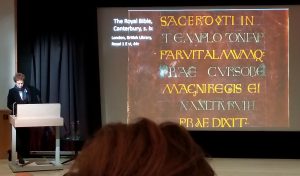
Julia Smith introduces The Royal Bible of Saint Augustine’s Abbey Canterbury in her Plenary Lecture in December 2018.
II. Documents in Question
Curiouser and Curiouser
A Most Strange Seal on a Paper Document of A.D. 1345, Old Style, from Grenoble.
Scrap of Information
A Puzzling Fragment from a French Charter with the Date, Maybe Accurate, of 1538.
Full Court Preston
A Pair of 13th-Century Documents, Missing Their Seals, from Preston, Near Ipswich, in Suffolk
(Competition with Book Prizes Included).
Italian Notarial Roll of 1305 from Cesena
A complete documentary scroll from Emelia-Romagna in North-East Italy, with Notarial Sign and Signature.
Lillian Vail Dymond
A guest blogpost by Linde M. Brocato considers the case, such as by adoption, of the several names which official documents might adopt at various times when referring to a single individual, particularly for an individual whose history passes through various times and places with different forms of record.
Heidere Diplomas & Investiture
Celebrating collegiality, we presented a supersized pair of especially designed ‘Diplomas’ (official and unofficial) for our Honorary Invited Associate, James P. Heidere, D. D. S., when he requested a diploma attesting to that honor, to hang in his dental office, along with all the others.
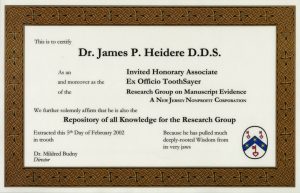
Heidere Diploma 2 in the Unofficial Version
Fit to Be Tied
A single-sheet document of Cardinal–Bishop Bérengar de Frédul concerning a dispute at Calahorra, bearing the date 13 July 1320, and carrying a red cord tie.
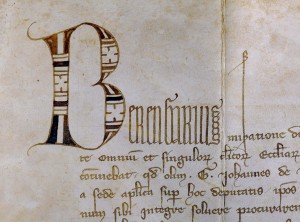
Say Cheese
An Undated Single-sheet Document in French, written by a single hand probably during the 1530s (presumably in the very region), records a survey of rents for plots of land from the region of Brie in France.
Latin Document of 1437 on Vellum from Barcelona
A single-sheet document records one or more transactions concerning the sale of property from one “transporter of animals” to another (curritorem animalium). Apparently this large sheet formerly served as the cover for the Fragments of a Castle ‘Capbreu’ from Catalonia (below).
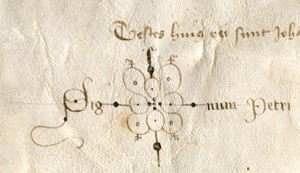
Notarial Signature Version 1
Preston Take 2
Following Full Court Preston (see above), the pair of 13th-century charters from Preston, recording the transfer of land from one individual to another, receive their prize-winning transcriptions and translations, now in the context of their larger group. There they comprise Charters 5 and 7.
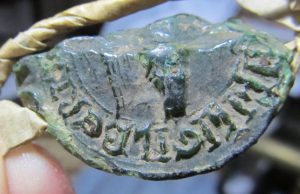
Preston Charter 7 Seal Face with the name Gilbertus.
Preston Charters, Continued
Turning to Charters 6 and 9 of the Preston Charters, with one undated and the other dated to the reign of Edward II.
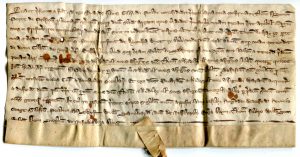
Preston Charter 6 Face.
Charter the Course: More on Preston Charters
Charters 10 and 11 of the Preston Charters, both dated to the reign of Edward II.
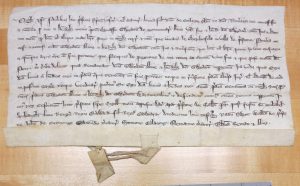
Preston Charter 10 Face. Photograph Mildred Budny.
Preston Charters: The Chirographs
Charters 12 and 13 of the Preston Charters, in the form of Chirographs, dating from the reigns of Edward IV and Elizabeth I, with Seals.
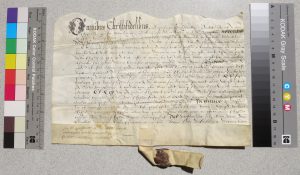
Preston Charter 13 Face with Seal. Photograph Mildred Budny.
More Light on English Charters
2 more medieval and early modern English charters in Latin have surfaced in the same collection as the Preston Charters explored in earlier posts.
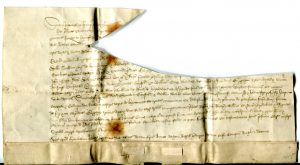
10 Henry VII Face.
A Charter of 1399 (23 Richard II) from High Ongar in Essex
A single-sheet Latin charter issued at Alta Aungre (High Ongar) in Essex on 17 July 1399, in Year 23 of the Reign of Richard II, refers also to other nearby places, which can be identified with reference to other surviving records.
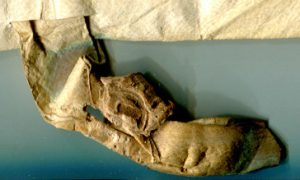
Private Collection, Document of 23 Richard II, Tag and Seal.
Vellum Binding Fragments in a Parisian Printed Book of 1538
A pair of strips from a signed legal document of some sort in Middle French remains in situ as the vellum supports for the outer gatherings of a copy, now lacking its binding, of L’Henry-Metre, Instrument Royal et Universal avec sa théorique, usage et pratique démontrée, by Henri de Suberville, printed in Paris by Adrien Périer in 1598.

Smeltzer Collection, Henri de Suberville (1598), Vellum Support, Strip 2, Outer Flap ‘Rejoined’.
III. Isolated Manuscript Fragments
The Mass of Saint Gregory, Illustrated
A Leaf from a Prayerbook with a Late 15th-Century Illustration, probably made in France or the Netherlands, of the visionary Mass performed by Gregory the Great. To him appears the figure of Christ surrounded by Most of the Instruments and Agents of His Passion, upon a brilliant blue background.
Leaf from a Tiny Book of Hours
A Leaf from the Hours of the Virgin in an Unknown 15th-century Book of Hours.
A Leaf from the Office of the Dead
Part of the Office of the Dead from a 15th-century Book of Hours made in Flanders (perhaps at Bruges or Antwerp) circa 1470
— with a Personal Reflection on the Subject, occasioned by the death of Jennifer O’Reilly (1943–2016).
Part-Leaf from a Large-Format Lectionary
Parts of I Maccabees 10 and Homily 38 on the Gospels by Gregory the Great from a large-format Latin lectionary, probably made in Italy, perhaps Northern Italy, circa 1175, now reduced to the lower part of the leaf, for reuse as a wrapper or binder for unknown materials, and now retrieved as a solitary item.
Three Leaves from a Latin Religious Pocket Handbook
3 Non-Continuous Leaves from a 14th-Century Handbook of Texts for Religious & Liturgical Practice including parts of Psalm 77 (78 ) and Eadmer’s Tractatus de Conceptione Beatae Mariae.
Written in the Stars
A pair of continuous leaves from the end of a Roman Breviary, with lections from Patristic sermons by Leo the Great, Gregory the Great, and Augustine of Hippo about the Visit of the 3 Magi to the Christ Child and the rôle of the Star(s), in a learned denial of the powers of astrology. Perhaps from the same collection at Büdingen as the Vellum Bifolium from Augustine’s Homilies on John and the Selbold Cartulary Fragments?
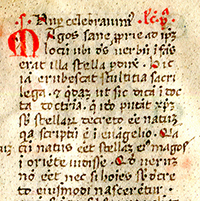
Spoonful of Sugar
A bifolium from a Latin treatise on medical substances from an unknown center, reused as the cover for a thick book bound with wooden boards and subsequently retrieved, with the loss of most of its contextual context — but perhaps now recoverable in part with wider awareness of this solitary survival.
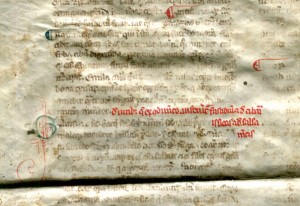 It’s a Wrap
It’s a Wrap
A decorated and annotated leaf from a large-format copy of the Novels of Justinian’s Code, made almost certainly at Bologna (or Padua) circa 1260–1280, found reuse as a wrapper, pasted and folded, with added tie, for other stuff (now lost).
A Reused Part-Leaf from Bede’s Homilies on the Gospels
A vellum part-leaf from a 14th-century large-format Latin copy of Bede’s Gospel Homilies (and perhaps other texts) in double columns, perhaps made in France, found reuse as part of a cover apparently for a modern land ledger (now lost) and then retrieval as a scrap on its own for sale from France.
A Leaf from Gregory’s Dialogues Reused to Bind Euthymius
A leaf from the Dialogues of Pope Gregory the Great (Book III.7), copied probably in Germany circa 1175, and reused as the cover for the binding of a copy (now lost) of Euthymius Zigabenus’s Commentary on the Psalms.
Another Witness to the Cistercian Statutes of 1257
A Part-Leaf, now on its own, carries parts of the Chapter De Conversis (“On the Lay Brothers”) from Distinctio (“Section”) XIV (out of XV in total) in the Codification of 1257 of Statutes for the Cistercian Order.
A 12th-Century Fragment of Anselm’s Cur Deus Homo
A fragmentary vellum leaf from chapters close to the end of Anselm’s theological–philosophical masterwork “Why God Became a Man” has surfaced in France, removed from its former use as the cover or wrapper, with flap closure, for some now-lost materials, presumably a book or notebook on paper. This fragment joins the select corpus of early manuscript witnesses to the text.
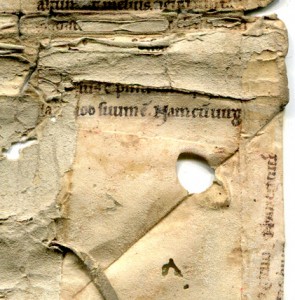
Verso of the Leaf and Interior of the Binding, Detail: Lower Right-Hand Corner, with the Mitered Flap Unfolded.
A Part-Leaf from ‘The Life of Saint Blaise’
A fragmentary leaf from a 12th-century manuscript containing, or partly containing, one or more saints’ lives intended for reading aloud survives its reuse as a limp-vellum cover for an 18th-century paper notebook comprising a register of receipts in French — perhaps a clue for its earlier provenance.

Recto of Part-Leaf from the Passio Sancti Blasii in a private collection.
Vellum Bifolium from Augustine’s Homilies on John
A newly acquired fragment of a vellum bifolium, recovered from its intermediary state as a cover for some other textual material apparently at Büdingen, in Hesse, Germany, comes from a 12th-century large-format copy in double columns of the Sermons on the Gospels of John by Augustine of Hippo. Probably from the same collection at Büdingen as the Selbold Cartulary Fragments.
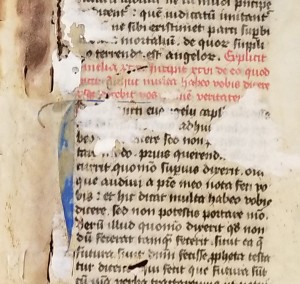
Sanskrit and Prakrit Manuscripts
We showcase a selection of fragments from palm-leaf and paper manuscripts in a single private collection.
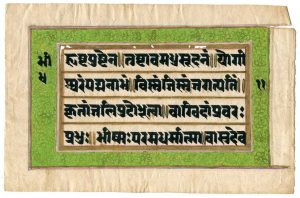
The Penitent King David from a Book of Hours
A detached leaf, framed behind glass, with a frontispiece illustration of King David, with discarded crown and lyre, for the opening of Psalm 4 or 37 (38) in the Vulgate Latin version.
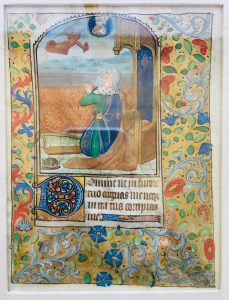
J. S. Wagner Collection. Detached Manuscript Leaf.
A Leaf from Prime in a Large-Format Latin Breviary
A detached leaf bearing the modern number “4” on its recto presents parts of the service for the Hour of Prime in a former manuscript, with script and decoration indicating an origin probably in Spain in the 16th or 17th century.
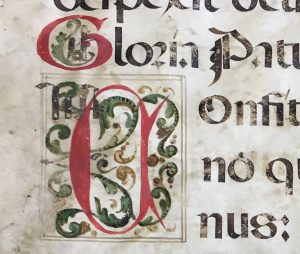
J. S. Wagner Collection. Leaf “4” Recto, detail. The opening of Psalm 117 (118) in the Vulgate Version, with a framed initial C for ‘Confitimini’.
The Pearly Gateway:
A Scrap from a Latin Missal or Breviary
A scrap of 7 lines from a vellum leaf of a Latin Missal or Breviary in Gothic script, now in a private collection, reveals its former reuse as part of a binding for some other material.
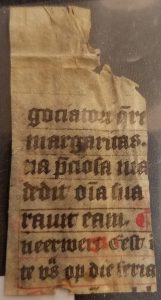
Simurgh and Zal from a Persian Shahnameh
A detached leaf from a Persian Shahnameh, perhaps 19th-century, includes an illustration depicting Simurgh and the adult Zāl, both poised in mid-flight.

Selbold Cartulary Fragments
A fragment of 3 leaves of a late-medieval copy on paper from a Cartulary, Liber, or Diplomatorium of the Rights and Privileges of Kloster Selbold in Hessen, Germany, deserves consideration as a witness to the complex and partly fragmented transmission of the documentary history of that center, including the several known copies of its Cartulary made or augmented at various dates, medieval and later. Probably from the same collection at Büdingen, in Hesse, as
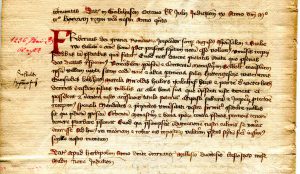
Selbold Cartulary Fragment folio “3” verso upper portion. Text 7: Frederick II, May 1236.
Fragments of a Castle ‘Capbreu’ from Catalonia
Fragments on paper from a late-medieval ‘Capbreu’ (or Terrier) in Latin and Catalan, from Castellví in Barcelona, are examined in their context. It appears that their context includes the Latin Document of 1437 on Vellum from Barcelona (above), which now calls for re-examination as the former cover for that book.
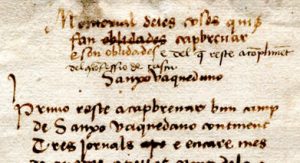
Private Collection, Castle Cartulary Fragment, Inserted Folded Sheet, Opened: Top Right.
Carolingian Fragment from Gregory’s “Homiliae in Evangelia”
Hitherto unknown fragments of a reused vellum bifolium from the Homiliae in Evangelia in Latin by Gregory the Great are reproduced, described, and analyzed, showing that they reveal a telling witness to the text, as Gregory’s revisions unfolded.
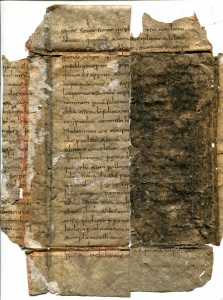
Private Collection, Bifolium of a Carolingian Copy of the Homilies on the Gospels by Gregory the Great. Photograph reproduced by permission.
An Illustrated Leaf from the Shahnameh with a Russian Watermark
A detached leaf from an illustrated Persian manuscript of the Shahnemeh (Humai and Darab) has a Russian watermark, on “official” paper with a dated watermark – in this case, either (18x)1 or (18)1x, with a script M from the maker’s initials — as a security feature.
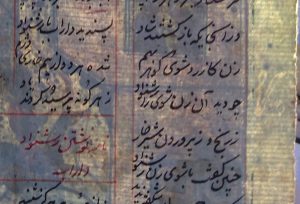
Luke’s Collection, Persian Leaf with Shahnameh volume 5, text side of the leaf backlit, with detail of watermark. Reproduced by permission.
Two Vellum Leaves from a Large-Format Latin Psalter in Gothic Script on Vellum
Two discontinuous single leaves on vellum from a dismembered late-medieval Latin Breviary in Gothic Script (folios ‘130’ and ‘137’) look for their former siblings.
[Update: In a comment to the post, Joanne Overty observed: “Looks like two leaves from a Northern Italian choir book (probably from the psalter). Mid 15th c.”]
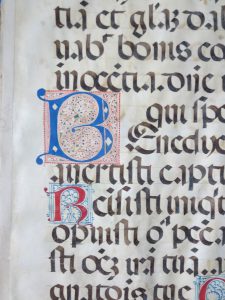
Private Collection, MS 1, Fol. 130r, initials B and R. Photography Mildred Budny. Reproduced by permission.
IV. Dispersed Manuscript Fragments Reassembled, at Least Virtually
Among them, a variety of manuscripts dispersed by Otto Ege (1888–1951). We considered them in the order in which they came to us, that is, in which they came to our notice for examination and study, with updates as research unfolded and more discoveries appeared.
A New Leaf from ‘Otto Ege Manuscript 41’
Part of the Dialogues of Pope Gregory the Great (Book III.12–14) from a 15th-Century Manuscript Plundered in Belgium in World War I
More Discoveries for ‘Otto Ege Manuscript 41’
Further research on manuscripts dispersed by Otto Ege yields discoveries for some, including ‘Ege Manuscript 41’ with Gregory’s ‘Dialogues’ and more texts as well.

Leaf 41, plus mat and label, in the Family Album of Otto Ege’s Portfolio of ‘Fifty Original Leaves’. Otto Ege Collection, Beinecke Rare Book and Manuscript Library, Yale University. Photograph by Mildred Budny.
A New Leaf from ‘Otto Ege Manuscript 61’
Part of Ezekiel 10–11 from a 32-Line Vulgate Pocket Bible from France
More Discoveries for ‘Otto Ege Manuscript 61’
Further research locates and identifies more leaves from the Pocket Vulgate Bible of “1310 A.D.” from France distributed in fragments by Otto Ege.
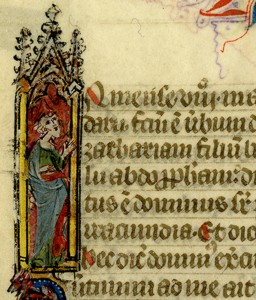
Opening Lines of the Book of Zachariah. Courtesy of Flora Lamson Hewlett Library, Graduate Theological Union, Berkeley, CA. Reproduced by permission.
A New Leaf from ‘Otto Ege Manuscript 8’
Latin Processional for Palm Sunday for Singing Nuns: A Detached Leaf from ‘The Wilton Processional’
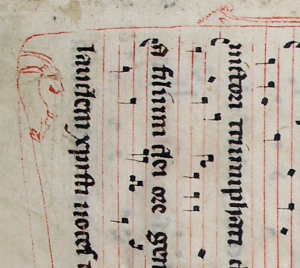
A New Leaf from ‘Otto Ege Manuscript 14’
Part of the Interpretation of Hebrew Names (Alcath – Ananias)
from a 50-line Vulgate Lectern Bible with Splendid Decoration and Illustration, as Once Was
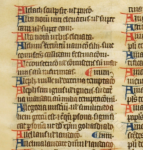
More Discoveries for ‘Otto Ege Manuscript 14’
The deposit of the Ege Family Collection in the Beinecke Rare Book and Manuscript Library brings to light more remnants from the large-format Lectern Bible

“A Long Shot”. New Acquisitions Exhibition at the Beinecke Rare Book and Manuscript Library in November 2016: View of Some Parts of “Otto Ege Manuscript 14”. Photography by Mildred Budny.
More Leaves from ‘Otto Ege Manuscript 51’
Some more leaves from Ege’s Erfurt Manuscript of 1365 CE of Aristotle’s Nichomachean Ethics in Latin Translation on Paper can be identified
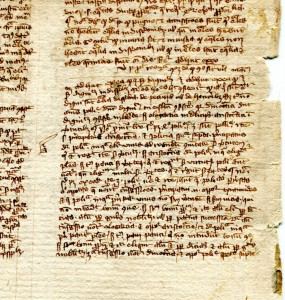 More Parts of ‘Otto Ege Manuscript 51’
More Parts of ‘Otto Ege Manuscript 51’
The deposit of the Ege Family Collection in the Beinecke Rare Book & Manuscript Library brings to light more remnants from this composite manuscript, including the carcass of its Volume II, fragments of the binding included.
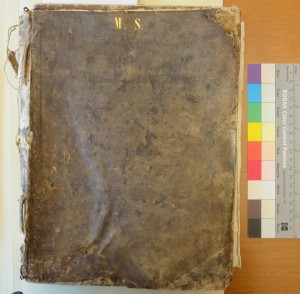
Otto Ege Collection, Beinecke Rare Book and Manuscript Library, Yale University. Ege Manuscript 51, Volume II, Front Cover. Photograph by Mildred Budny.
Updates for Some ‘Otto Ege Manuscripts’ (Ege MSS 8, 14, 41, and 61)
While we continue to find more evidence that updates, upsets, revises, and refines the accumulating awareness of Otto Ege’s dispersed manuscripts, and before we can write up all the discoveries, here is a Summary and Place-Holder.
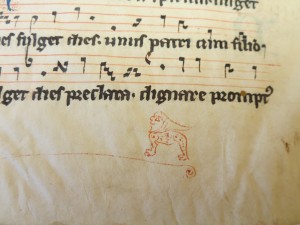
Beinecke Rare Book and Manuscript Library, Otto Ege Collection, Family Album, Leaf from ‘Ege Manuscript 8’, Recto, Detail.
New Testament Leaves in Old Armenian
A Pair of Leaves Identified, Described, Collated, and Set into the Context of its Manuscript, with a Downloadable Booklet (showcasing the Armenian font for the next version of our multilingual font Bembino).
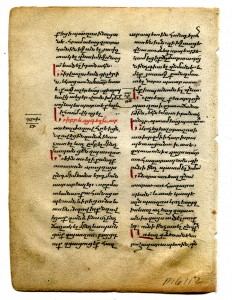
Folio I v of Armenian New Testament fragment. Acts of the Apostles
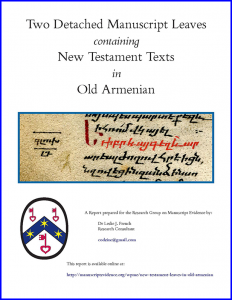
The Plot Thickens
A New Leaf Found at the University of Pennsylvania from the “Kurdian/Chicago New Testament Praxapostolos[?] in Old Armenian”, as we continue to chase its dispersed fragments (see New Testament Leaves in Old Armenian). That it appears as an extra element within a set of one of Otto Ege’s Portfolios (Famous Bibles), as sold by Dawson’s Bookshop, adds complexity to interconnected networks of dispersal.
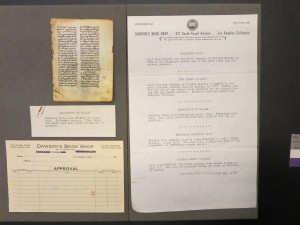
A New Leaf from “Otto Ege Manuscript 214”?
A detached leaf of text from a 22-Line Prayerbook in Dutch, probably from the Collection of Otto F. Ege.
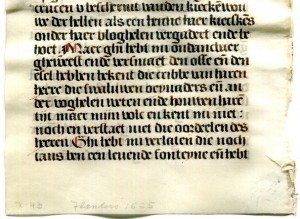
Private Collection. Leaf from a Dutch prayerbook, detail.
A Leaf from ‘Otto Ege Manuscript 19’ and Ege’s Workshop Practices
A detached leaf from ‘Otto Ege Manuscript 19’, now in the J. S. Wagner Collection, provides the transition from one Old Testament Book to the next, and gives the opportunity to examine Ege’s habits in mounting and distributing manuscript leaves.
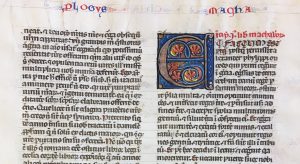
Wagner Collection, Leaf from Otto Ege Manuscript 19, verso.
Some Leaves in Set 1 of Otto Ege’s FOL Portfolio (Ege MSS 8, 14, 19, and 41)
The newly discovered Set 1 (of 40 numbered sets) of Otto Ege’s Portfolio of Fifty Original Leaves from Medieval Manuscripts, Western Europe: XII–XVI Century (FOL) allows us to examine its leaves from ‘Ege Manuscripts 8, 14, 19, and 41’ (of 50 manuscripts) with varied types of texts, scripts, and styles.
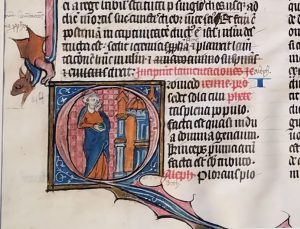
Set 1 of Ege’s FOL Portfolio, Leaf 14 recto: Lamentations Initial.
Updates for ‘Otto Ege Manuscript 19’
An update for our research on the dispersed fragments of ‘Otto Ege Manuscript 19’ examines its description in the 1936 Sotheby’s auction catalogue while the volume was still intact.
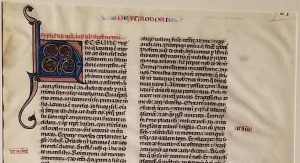
Set 1 of Otto Ege’s FOL Portfolio, Leaf 19 recto top.
Patch Work in ‘Otto Ege Manuscript 14’
Patched repairs for some leaves in ‘Otto Ege Manuscript 14’, a dismembered large-format Vulgate Bible examined in several of our blogposts, redeploy parts from other leaves of the same book, from positions therein now partly identified; these locations augment the list of surviving remnants, which now extend into known parts of leaves, as well as the increasingly recognized full leaves or bifolia.
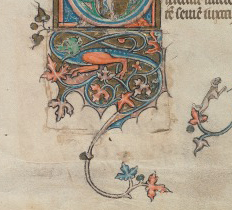
Beinecke Rare Book & Manuscript Library, Otto Ege Collection, MS 14, Genesis Opening Leaf: Recto, Detail of Patch.
Otto Ege’s Portfolio of ‘Famous Books’ and ‘Ege Manuscript 53’ (Quran/Koran)
Introducing a newly revealed set of the Portfolio of Famous Books in Nine Centuries (FBNC) by Otto Ege, we begin with its first Leaf, from a medieval Koran/Quran on paper.
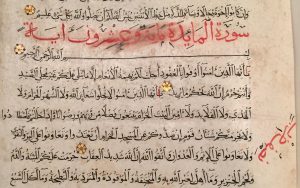
Private Collection, Koran Leaf in Ege’s Famous Books in Nine Centuries, Back of Leaf, Detail. Reproduced by permission.
Otto Ege’s Aquinas Manuscript in Humanist Script (‘Ege Manuscript 40’)
Part I of III in a series about this manuscript
The newly revealed set of Ege’s Portfolio of Famous Books in Nine Centuries (see above) leads us to examine its specimen from a late 15th-century copy in Latin on vellum of the Commentary by Thomas Aquinas on the Sentences of Peter Lombard, to survey other leaves from the same book (found in other sets of that Portfolio as well as in the FOL Portfolio as Number 40), and to consider its manuscript context.
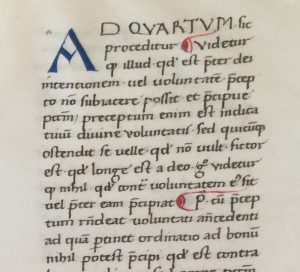
Private Collection, Ege’s FBNC Portfolio, Aquinas Leaf, Recto, Top Right. Reproduced by Permission.
Otto Ege Manuscript 40, Part II: Before and After Ege
Part II of III in a series about this manuscript
Examining specimens of Ege Manuscript 40 (Aquinas) leads us to consider the sales catalogues which describe it before and after dismemberment.
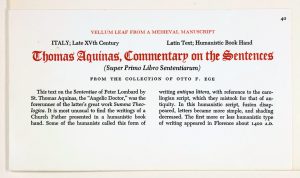
Otto F. Ege: Fifty Original Leaves from Medieval Manuscripts, Leaf 40, Printed Label, Special Collections and University Archives, Stony Brook University Libraries.
Specimens of ‘Ege Manuscript 40’ (Aquinas) in the ‘Ege Family Portfolio’
Part III of III in a series about this manuscript
The specimens from the 15th-century Aquinas Manuscript in Humanist Script presented as Leaf 40 in the ‘Ege Family Portfolio’ (Set 3) of Fifty Original Leaves from Medieval Western Manuscripts (FOL) contain evidence of the character, ornate decoration, and ownership of the former volume.
[P. S. As more discoveries come to light, we prepare another blogpost to join this series on the manuscript, to appear as “Part IV of III” . . . ]
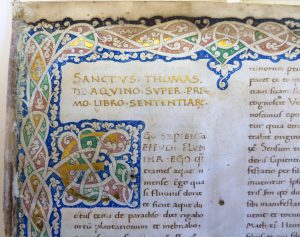
Beinecke Rare Book & Manuscript Library, Otto Ege Collection, FOL Set 3, MS 40, Specimen 1: folio ‘1’r, Top Left. Photography Mildred Budny.
Another Leaf from the Warburg Missal (“Otto Ege Manuscript 22”)
A detached leaf in the J. S. Wagner Collection from ‘Ege Manuscript 22’, the 14th-century Warburg Missal, presents part of the Mass for the Feast of Corpus Christi (Folio CLVI in the Temporal).
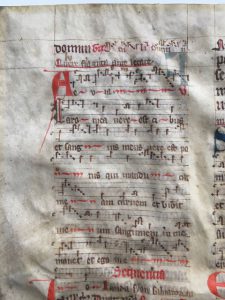
J. S. Wagner Collection, Ege Manuscript 22, Folio clvi, verso, top.
Accompanying this post is the 36-page Report Booklet by Leslie J. French (2021).
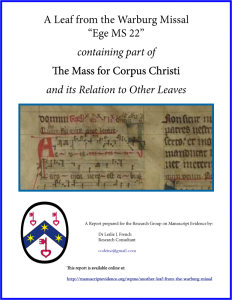
Front Cover for Report by Leslie J. French for Wagner Leaf from Ege MS 22 (2021)
A Leaf in Dallas from ‘Otto Ege MS 14’ (Lectern Bible)
A framed leaf now in the Virginia Lazenby O’Hara Fine Books Division of the Dallas Public Library, and formerly part of “Otto Ege’s Manuscript 14”, a 14th-century Latin Lectern Bible, is newly revealed.
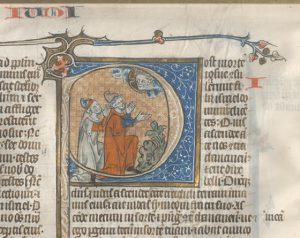
Virginia Lazenby O’Hara Fine Books Division, Dallas Public Library, Framed Leaf from Ege MS 14, top right. Opening initial for Judges 1:1. P for ‘Post’.
A Leaf of Deuteronomy from ‘Otto Ege Manuscript 14’ in the Rosenbrook Collection
A Leaf in the Brent Rosenbrook Collection from Deuteronomy in ‘Otto Ege Manuscript 14’ joins the virtual reconstruction of the manuscript.
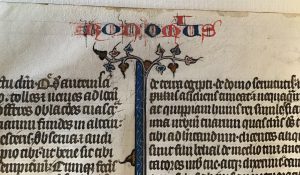
Brent Rosenbrook Collection, Leaf from Ege Manuscript 14, ‘Recto’ (original Verso), top.
Two Old Testament Leaves from ‘Otto Ege Manuscript 14’ at Smith College
Two single leaves from ‘Otto Ege Manuscript 14’, a large lectern bible, survive at Smith College from the Books of Exodus and Exekiel. We learned about this leaf thanks to Hannah Goeselt, who now contributes to this blog as Guest Blogger (see below).
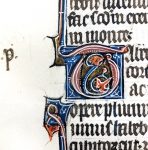
Smith College, MS 35-14, recto, detail: Initial for Exodus 26. Photography by Hannah Goeselt.
Two Ege Leaves and Two Ege Labels in the Collection of Brigitt G. Lopez
(Ege MS 14, MS 20, and MS 54)
Two single, framed, leaves from “Otto Ege Manuscripts”, respectively from “Ege Manuscript 14” and “Ege Manuscript 20”, retain their Ege Labels, which, as our investigation reveals, pertain respectively to Ege MS 14 and to Ege MS 54; from the latter manuscript, specimens sometimes would be swapped for “Ege MS 9” (another small-format Vulgate Bible manuscript) in some of Ege’s Portfolios. Those interchanges complicate the processes of identification.
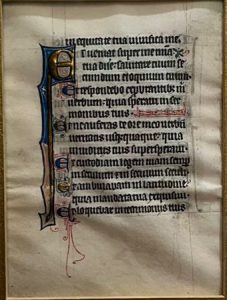
Collection of Birgitt G. Lopez, Framed Leaf from ‘Otto Ege Manuscript 20’, Front-Facing Page (“Recto”).
Another Leaf from a Portable Manuscript Bible in the Collection of Birgitt G. Lopez
A single leaf in the Collection of Birgit G. Lopez, in double columns of Gothic script in 56 lines, with a modern arabic folio number on the recto and an accompanying London seller’s label, came from a small-format 13th-century Vulgate Bible manuscript as yet unidentified. We examine its evidence.
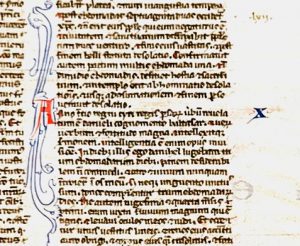
Collection of Birgitt G. Lopez, Vulgate Bible Manuscript Leaf purchased in London around 2000: Recto with opening of Daniel Chapter X.
More Leaves from an Old Armenian Praxapostolos
Following earlier discoveries, we present two newly discovered leaves from the Acts of the Apostles from an Old Armenian Praxapostolos in a Private Collection and in the Collection of Richard Weber.
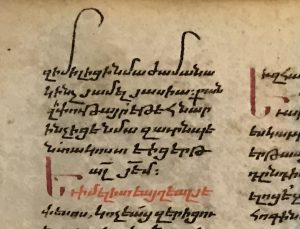
Collection of Richard Weber. Single Leaf from an Old Armenian Praxapostolos, Verso, Top Left.
A Leaf from ‘Otto Ege Manuscript 214’ in the Collection of Robert Weber
We showcase a single leaf from ‘Otto Ege Manuscript 214’ (a 14th-century prayerbook in Dutch) now in the Collection of Richard Weber.
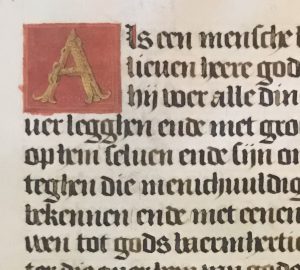
Richard Weber Collection. Single Leaf from “Otto Ege Manuscript 214”? Verso, Top Left. Image reproduced with permission.
A Detached Folio 108 with Part of Vulgate Psalm 118 (117)
We present a single large-format leaf with part of Vulgate Psalm 118, written in single columns of 14 lines, in the Collection of Stephen Soderlind.
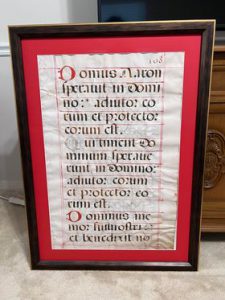
Collection of Stephen Soderlind, Single Leaf in Frame as purchased: Front of Frame. Reproduced by Permission.
Folio 4 with Latin Blessings for Holy Water and an Exorcism for Salt
A single leaf (folio 4) with Blessings and an Exorcism or Purification preserves a remnant of a 15th-century Latin manuscript for liturgical performance.
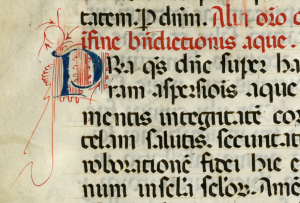
Private Collection, Single Leaf from a Latin Missal. Folio 4r, Detail. Reproduced by permission.
Portfolio 93 of Ege’s “Famous Books in Eight Centuries (FBEC)” in the Collection of Richard Weber
We showcase Set 94 (out of 110 numbered sets) of Otto Ege’s Portfolio of “Famous Books” in Eight Centuries, with leaves from manuscripts and printed books — plus surprises.
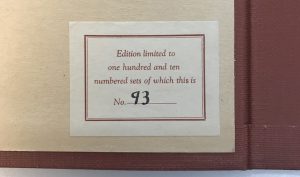
Richard Weber Collection, Famous Books in Eight Centuries, Portfolio 93, Inside Front Cover, Edition Label with Portfolio Number. Reproduced by Permission.
V. Manuscript Leaves or Bifolia
Reused as Covers for Later Materials and Still In Situ
A Part-Leaf from ‘The Life of Saint Blaise’
A fragmentary leaf from a Latin lectionary found its way forward as a reused limp vellum cover for an 18th-century paper notebook used as a register for receipts in French in the area of Plauzat in the Auvergne.
 Cover-Up
Cover-Up
A reused medieval bifolium with parts of Psalms 77 (78) and 87 (88), from a medium-format Latin Psalter made in the late 13th or early 14th century,
covers a 18th-century paper notebook of receipts in French relating to Dijon and its region
Note: Another post (see above under Documents) reports on some cut-up and reused written fragments still within the sewing of a binding.
As above:
Vellum Binding Fragments in a Parisian Printed Book of 1538
Strips from a legal document of circa 1510–1520 in Middle French form supports or guards for some gatherings in a copy of Henri de Suberville (1598).
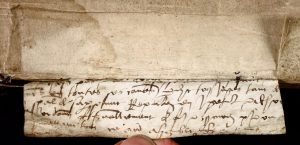
Smeltzer Collection, Henri de Suberville (1598): Vellum Support 1, Flap, Face with Text (Left-Hand Half).
VI. Manuscripts and Composite Manuscripts
A Composite Volume from Le Parc Abbey
Budny Handlist 15
“Albertus Magnus” (AKA Hugh Ripelin) Meets Peter the Venerable in a pair of partly decorated 15th-century Latin manuscripts from Le Parc Abbey in Belgium. Formerly separate, they were bound together in the 17th or 18th century at the abbey and sold along with many of its books in the 19th century.
An initial report appeared in a paper for one of our 2016 Conference Sessions, as reported in its Abstract: “Double Act: Manuscripts Combining Paper and Parchment”.
- Part A: “Albertus Magnus” AKA Hugh of Ripelin
- Part B: Peter the Venerable
A Sinhalese Palm-Leaf Manuscript in Deconstructed and Reconstructed Order
Part 1 of 2.
A Sinhalese palm-leaf manuscript, now in a Private Collection, represents a chopped and reassembled semblance of its former self, which we begin virtually to reconstruct, with guides for ‘deciphering’ their features and requests for help in this quest.
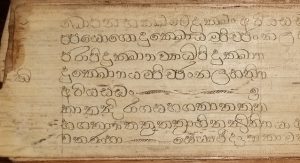
Private Collection, Sinhalese Palm-Leaf Manuscript, End-Leaf 01, Left.
More Leaves from a Deconstructed Sinhalese Palm-Leaf Manuscript
Part 2 of 2.
We show more of the half-leaves from the bisected and reassembled Sinhalese palm-leaf manuscript, to aid in the reconstruction and identification of its original character.
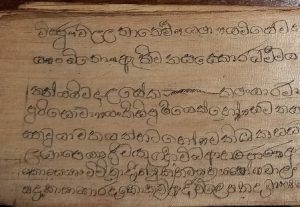
Private Collection, Sinhalese Palm-Leaf Manuscript, Leaf ’30’, Side A, Detail (Leaf-Hand-Half). Reproduced by Permission.
VII. Early Printed Materials
In progress: An on-going study of a rare Postilla, printed in Lyons in 1523, examines its surviving text-block, which lacks its binding, and some fragments — discarded and reused leaves from a medieval Latin manuscript and some scraps of printer’s waste also in Latin — which came from the boards of both front and back covers (for which they were pasted together).
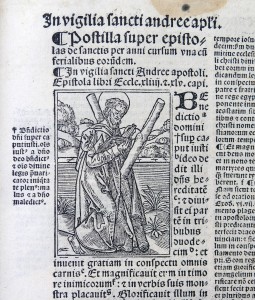
Saint Andrew and His Book
A fore-taste appears on our page for Watermarks & the History of Paper.
Carmelite Missal Leaf of 1509
A detached leaf from the Missal for Use in a Carmelite Monastery, printed by Lucantonio Giunta in Venice on 15 January 1509, preserves part of the Mass for Holy Saturday in Easter Week, including music for the Kyrie in square notation on 4-line staves.
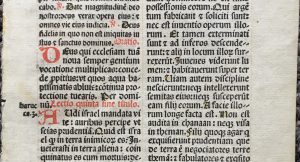
J. S. Wagner Collection, Leaf from a Latin Missal for Carmelite Use, printed in 1509 Lucantonio Giunta in Venice. Recto, detail: Middle Portion. Reproduced by Permission.
Our study of the leaf also yields a 12-page Report on “A Process of Discovery” by our Associate and Font-Designer, Leslie J. French, freely available in download through the post.
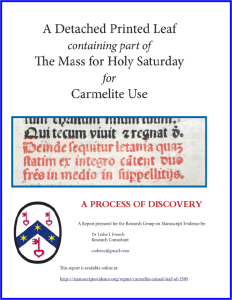
Camelite Booklet Cover
VIII. Books Telling Their Stories
Here we launch a group of blogposts devoted to the narratives, illustrative cycles, and other signs which express, or make manifest, the stories which they portray in word or image, or which have become inscribed upon their surfaces or within their very ‘bones’.
The first of these focuses upon a selection of late medieval manuscripts which share cycles of illustration.
“Lead the People Forward” (by Zoey Kambour)
“Lead the People Forward: The Contemporaneity of the Medieval Iberian Haggadah”
In a peer-reviewed paper, our Guest Blogger, Zoey Kambour examines visual anachronism in the Exodus illuminations of two celebrated medieval Haggadah manuscripts now in London and Manchester.
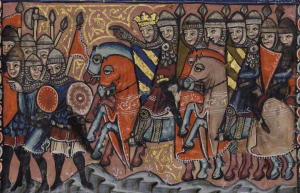
Pursuit by the Egyptians. Manchester, John Rylands Library, Rylands Heb. MS 6, fol. 18v, lower. Copyright of the University of Manchester.
A 13th-Century Pocket Vulgate Bible at Smith College: The Dimock Bible (by Hannah Goeselt)
(30 October 2023)
Guest Blogger Hannah Goeselt gives a guided tour of “The Dimock Bible”, a 13th-century Pocket Vulgate Bible at Smith College (MRBC MS 240), with decorated and historiated initials, annotations, and the ghost-like impression of an object — medieval seal or seal matrix perhaps? — which once was pressed between two facing pages.
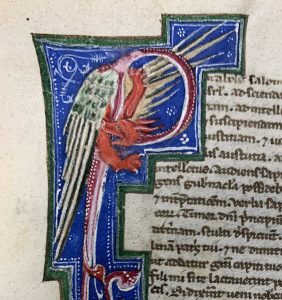
Smith College, MRBC MS 240, fol. 25v. Proverbs Initial with Dragon. Photography by Hannah Goeselt.
*****
IX. For Future Reference
[More to come . . .]
Watch this Space.
*****
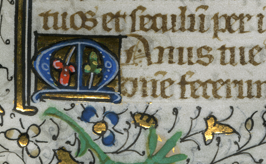
Initial M for “Manus” (“Hand”).
Do you have requests or suggestions for subjects for this blog?
Do you have materials — manuscripts, fragments, documents, seals, or archival, numismatic, epigraphical, and other specimens — to show?
Would you like to contribute? Please let us know.
We welcome suggestions and feedback.
Contact Us, leave a Comment here, and visit our Facebook Page.
*****

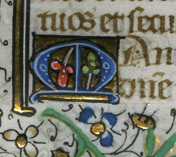
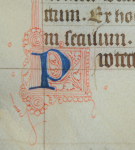
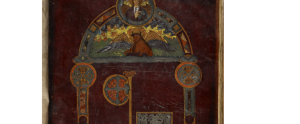
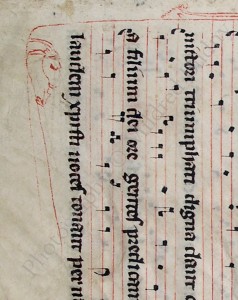


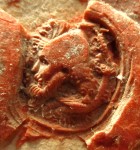
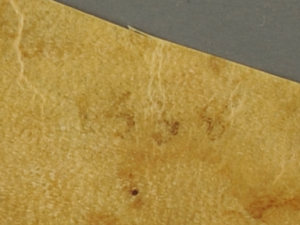
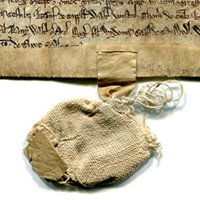
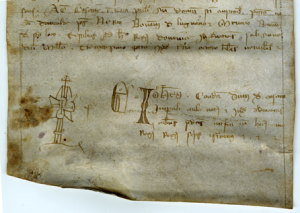
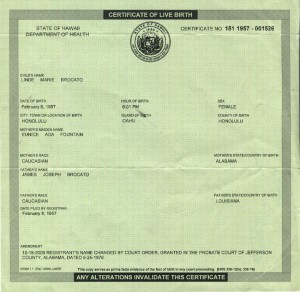
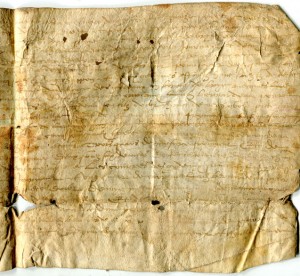
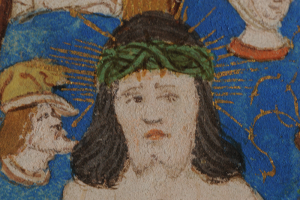
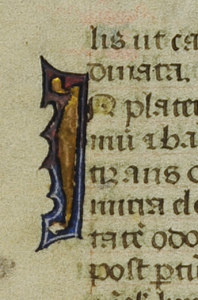

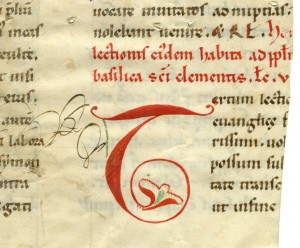
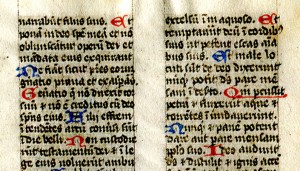
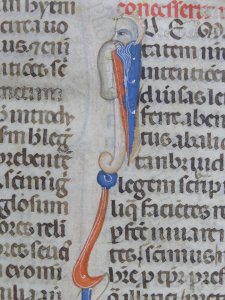
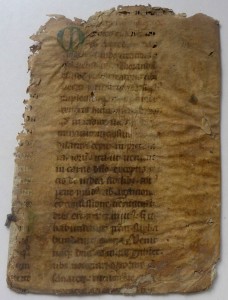
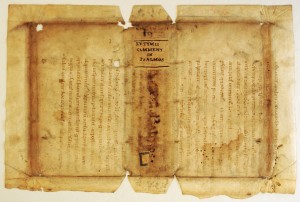
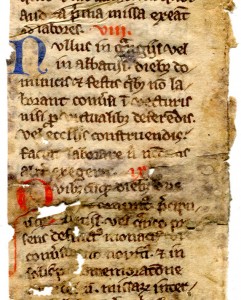
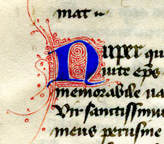

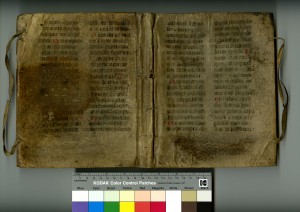
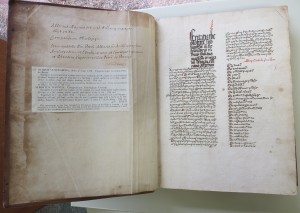
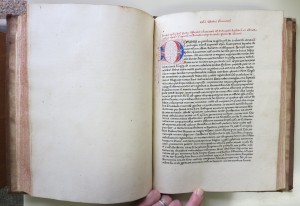
Wonderful to see how the research continues to reveal more and more discoveries.